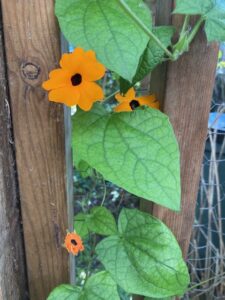Among the many seeds we sowed in the greenhouse this spring was a selection of annual climbers. They have taken their time to get going, perhaps owing to being sown a little later than ideal, I have to admit, but I think some of the blame can be laid at the door of this gloomy summer, which has not been a great one for anything that likes a lot of sun. Anyway, now, at the tail end of summer, they are really starting to show their colours, and I love the way they add a new dimension to the garden and with such a light footprint, clambering eagerly up places there have never been climbers before, adding a bit of late-summer drama.
First up is Mina lobata, so called the ‘Spanish flag’, so called because the little tubular flowers stand out, flag like, from the flower stems, and in the colours of the Spanish flag, red and golden yellow (though with a little orange in the mix too). These are such a beautiful and striking presence in the garden.

Chilean glory flower, Eccremocarpus scaber, is a beauty, with delicate bright green scrambling stems and lipstick red flowers. It reminds me a little in its effect of the flame flower, Tropaeoleum speciosum, a type of climbing nasturtium that I have seen growing beautifully in Scotland, liking the acid soil conditions there, but which I have never managed to grow well, although I would love to. Both look stunning growing up through a yew hedge, the bright leaves and red flowers gorgeous against the deep green of the yew. Eccremocarpus is actually a perennial but is not hardy and so is usually grown as an annual in the UK, but when grown in mild areas it can sometimes come back after winter.
Perhaps my favourite this year has been black eyed Susan, Thunbergia alata. This is a half hardy annual native to east Africa, and it has grown well for me. It enjoys a little shelter and doesn’t like winds, and my garden is pretty sheltered. It also loves sun, which I haven’t been able to provide so much of this year but it has started flowering for me anyway. The flowers are really unusual, an oddly ‘flat’ sort of orange with a deepest black centre, and really the whole flower looks as if it has been painted by a toddler, or has popped out of the pages of a comic. Now that it has started to flower in profusion it is really striking in the garden, and really draws the eye.
All can be grown up uprights of garden railings, or given tripod supports of their own. They do well in pots, and look particularly good when scrambled together, their bright colours complementing each other. They are also wonderful in late summer borders where they will work well among the golden and red rudbeckias and sunflowers – perhaps I will grow some giant sunflowers next year and encourage mine to climb up their stems. But they are also beautiful among the purples and blues of Verbena bonariensis and Veronica.
They all need a little bit of warmth and cosseting early in the year in order to get them going. Ideally you would sow them in a heated propagator early in spring, and then move them out into the greenhouse once they have germinated. Give them a little protection even then as they will struggle if a late frost hits. Plant them out when all danger of frost has passed, and look forward to your late summer garden being draped and festooned with brightly coloured climbers.










